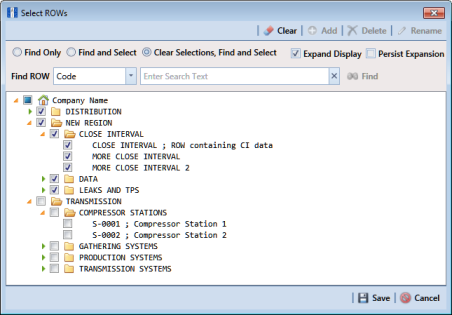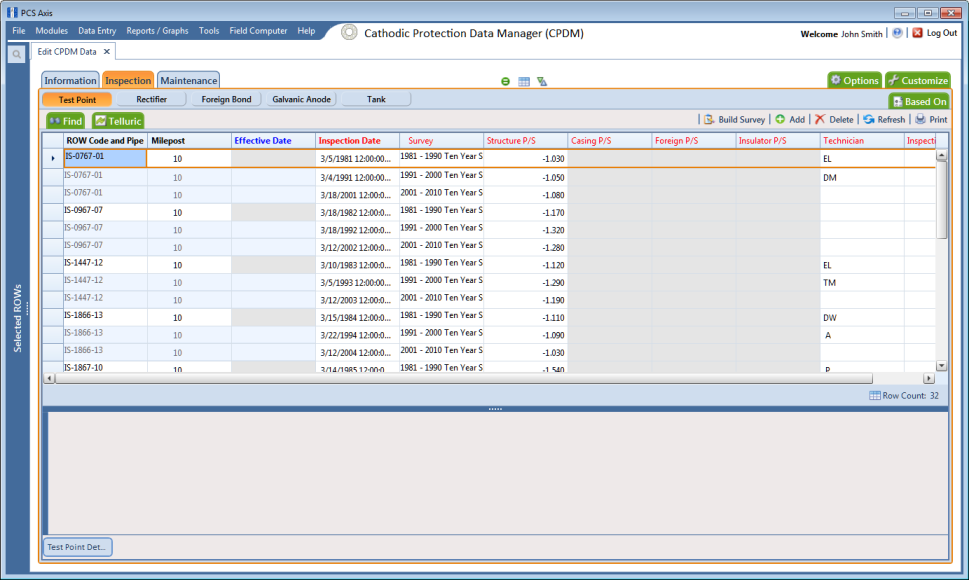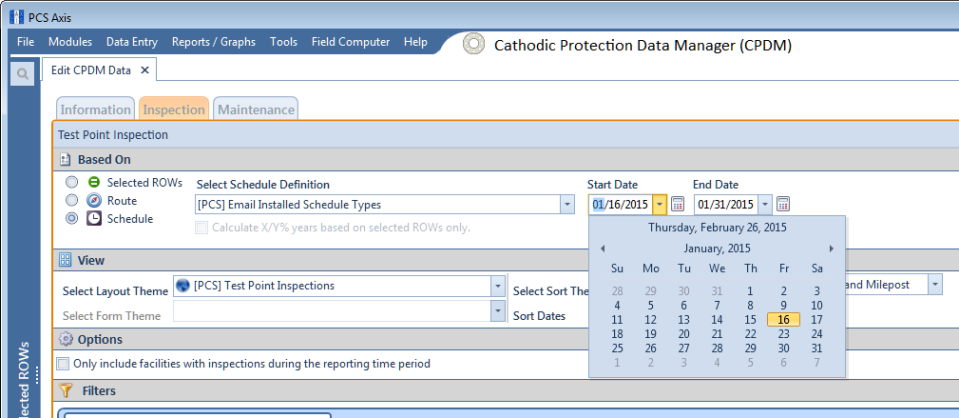Using the Based On Tab to View Records Based on a Schedule
Complete the following steps using the Based On tab to view records in a grid based on a schedule:
1 Select one or more pipeline segments in the
Select ROWs window (
Figure 7-42). Select pipeline segments with facilities included in a schedule, then click
 Save
Save to close the window.
Figure 7-42. Select ROWs
2 Open the
Edit <module> Data window. For example, click
Data Entry >
Edit CPDM Data to open the
Edit CPDM Data window (
Figure 7-43).
Figure 7-43. Test Point Inspection Grid
3 Select a data entry grid. For example, click the
Inspection tab

and then the
Test Point button

to display the
Test Point Inspection data entry grid.
4 If you want to collapse the Selected ROWs panel to view more of the grid, click the Selected ROWs bar. Clicking the bar again expands the panel.
5 Click the
Based On tab

and then select
Schedule (
Figure 7-44).
Figure 7-44. Based On Schedule
6 Select a schedule definition. Click the down arrow in the field Select Schedule Definition and select an item in the list.
Complete
step 7 to set up a schedule date range using a calendar or
step 8 to set up a schedule date range using dynamic dates.
7 To set up a schedule date range using a calendar:
a Set a schedule start date. Type a date in the
Start Date field or click the down arrow and select a date using a calendar
(Figure 7-45).
Figure 7-45. Start Date Field Calendar
b Set a schedule end date. Type a date in the End Date field or click the down arrow and select a date using a calendar.
Note: When typing a date, use the format MM/DD/YYYY to indicate the month, day, and year.
c Click
 Apply
Apply and then click
 Close
Close to close the based on panel. Records display in the data entry grid based on the selected schedule definition and date range.
8 To set a schedule date range using dynamic start and end dates, follow these steps:
a Click the
Start Date 
calculator to open dynamic start date fields. Set properties in these fields in the following manner:
1) Click the down arrow in the
Start Date field
(Figure 7-46) and select one of the following options:
Today,
End Of Month,
Beginning Of Year, or
End Of Year.
Figure 7-46. Start Date Options
2) In the remaining two fields, type an offset value in the first field and then click the down arrow in the second field and select one of the following options:
Day(s),
Month(s), or
Year(s). Click the

pencil button to close dynamic start date fields.
b Click the
End Date 
calculator to open dynamic end date fields. Set properties in these fields in the following manner:
1) Click the down arrow in the End Date field and select one of the following options: Today, End Of Month, Beginning Of Year, or End Of Year.
2) In the remaining two fields, type an offset value in the first field and then click the down arrow in the second field and select one of the following options:
Day(s),
Month(s), or
Year(s). Click the

pencil button to close dynamic end date fields.
c Click
 Apply
Apply and then click
 Close
Close to close the based on panel. Records display in the data entry grid based on the selected schedule definition and dynamic date range.
 Save to close the window.
Save to close the window. 



